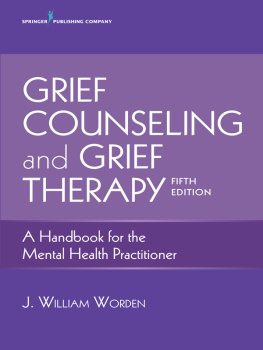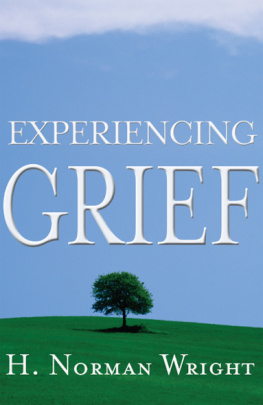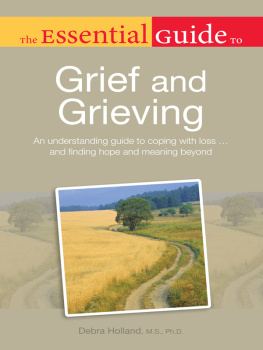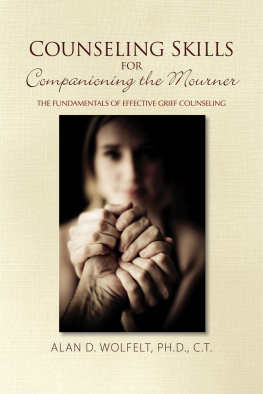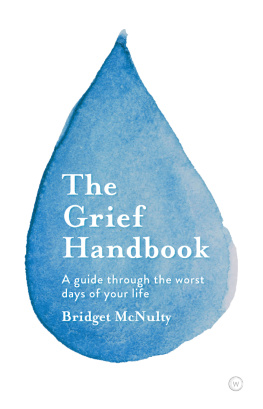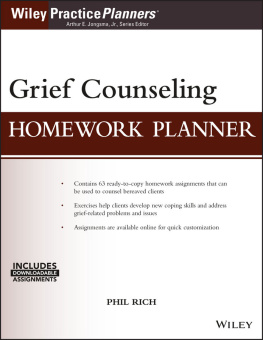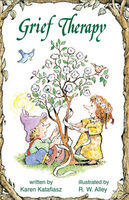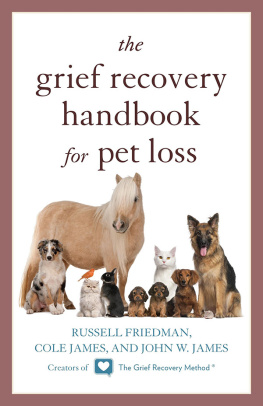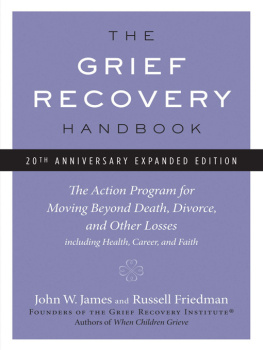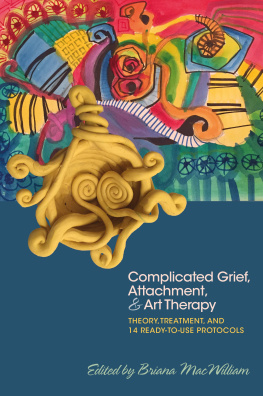J. William Worden - Grief counseling and grief therapy: a handbook for the mental health practitioner
Here you can read online J. William Worden - Grief counseling and grief therapy: a handbook for the mental health practitioner full text of the book (entire story) in english for free. Download pdf and epub, get meaning, cover and reviews about this ebook. year: 2018, publisher: Springer Publishing Company, Inc., genre: Religion. Description of the work, (preface) as well as reviews are available. Best literature library LitArk.com created for fans of good reading and offers a wide selection of genres:
Romance novel
Science fiction
Adventure
Detective
Science
History
Home and family
Prose
Art
Politics
Computer
Non-fiction
Religion
Business
Children
Humor
Choose a favorite category and find really read worthwhile books. Enjoy immersion in the world of imagination, feel the emotions of the characters or learn something new for yourself, make an fascinating discovery.
- Book:Grief counseling and grief therapy: a handbook for the mental health practitioner
- Author:
- Publisher:Springer Publishing Company, Inc.
- Genre:
- Year:2018
- Rating:3 / 5
- Favourites:Add to favourites
- Your mark:
- 60
- 1
- 2
- 3
- 4
- 5
Grief counseling and grief therapy: a handbook for the mental health practitioner: summary, description and annotation
We offer to read an annotation, description, summary or preface (depends on what the author of the book "Grief counseling and grief therapy: a handbook for the mental health practitioner" wrote himself). If you haven't found the necessary information about the book — write in the comments, we will try to find it.
J. William Worden: author's other books
Who wrote Grief counseling and grief therapy: a handbook for the mental health practitioner? Find out the surname, the name of the author of the book and a list of all author's works by series.
Grief counseling and grief therapy: a handbook for the mental health practitioner — read online for free the complete book (whole text) full work
Below is the text of the book, divided by pages. System saving the place of the last page read, allows you to conveniently read the book "Grief counseling and grief therapy: a handbook for the mental health practitioner" online for free, without having to search again every time where you left off. Put a bookmark, and you can go to the page where you finished reading at any time.
Font size:
Interval:
Bookmark:
Contents
ii J. William Worden, PhD, ABPP, is a Fellow of the American Psychological Association and holds academic appointments at the Harvard Medical School and at the Rosemead Graduate School of Psychology in California. He is also coprincipal investigator of the Harvard Child Bereavement Study, based at the Massachusetts General Hospital. A recipient of five major National Institutes of Health grants, his research and clinical work over 40 years has centered on issues of life-threatening illness and life-threatening behavior.
His professional interests led him to become a founding member of the Association of Death Education and Counseling (ADEC) and the International Work Group on Death, Dying, and Bereavement (IWG). With his colleague Dr. Avery Weisman, he pioneered the field of Psychosocial Oncology and is a Fellow of the American Psychosocial Oncology Society. Dr. Worden has also been active in the development of Hospice, serving on the board of the first U.S. hospice in Connecticut.
Dr. Worden has lectured and written on topics related to terminal illness, cancer care, and bereavement. He is the author of Personal Death Awareness and Children & Grief: When a Parent Dies, and is coauthor of Helping Cancer Patients Cope. His book Grief Counseling and Grief Therapy: A Handbook for the Mental Health Practitioner, now in its fifth edition, has been translated into 14 foreign languages and is widely used around the world as the standard reference on the subject. Dr. Wordens clinical practice is in Laguna Niguel, California.
ATTACHMENT, LOSS, AND THE EXPERIENCE OF GRIEF
ATTACHMENT THEORY
Before one can fully comprehend the impact of a loss and the human behavior associated with it, one must have some understanding of the meaning of attachment. There is considerable writing in the psychological and psychiatric literature as to the nature of attachmentswhat they are and how they develop. One of the key figures and primary thinkers in this area is the late British psychiatrist John Bowlby. He devoted much of his professional career to the area of attachment and loss and wrote several substantial volumes as well as a number of articles on the subject.
Bowlbys attachment theory provides a way for us to conceptualize the tendency in human beings to create strong affectional bonds with others and a way to understand the strong emotional reaction that occurs when those bonds are threatened or broken. To develop his theories, Bowlby casts his net wide and includes data from ethology, control theory, cognitive psychology, neurophysiology, and developmental biology. He takes exception to those who believe that attachment bonds between individuals develop only in order to have certain biological drives met, such as the drive for food or the drive for sex. Citing Lorenzs work with animals and Harlows work with young monkeys, points to the fact that attachment occurs in the absence of the reinforcement of these biogenic needs.
Bowlbys thesis is that these attachments come from a need for security and safety; they develop early in life, are usually directed toward a few specific individuals, and tend to endure throughout a large part of the life cycle. Forming attachments with significant others is considered normal behavior not only for the child but for the adult as well. Bowlby argues that attachment behavior has survival value, citing the occurrence of this behavior in the young of almost all species of mammals. But he sees attachment behavior as distinct from feeding and sexual behavior.
Attachment behavior is best illustrated by the young animal and the young child, who, as they grow, leave the primary attachment figure for increasingly long periods of time to search an ever-widening radius of their environment. But they always return to the attachment figure for support and safety. When the attachment figure disappears or is threatened, the response is one of intense anxiety and strong emotional protest. Bowlby suggests that the childs parents provide the secure base of operation from which to explore. This relationship determines the childs capacity to make affectional bonds later in life. This is similar to .
If the goal of attachment behavior is to maintain an affectional bond, situations that endanger this bond give rise to certain very specific reactions. The greater the potential for loss, the more intense and the more varied these reactions are. In such circumstances, all the most powerful forms of attachment behavior become activatedclinging, crying, and perhaps angry coercion. When these actions are successful, the bond is restored; the activities cease and the states of stress and distress are alleviated (, p. 429). If the danger is not removed, withdrawal, apathy, and despair then ensue.
Animals demonstrate this behavior as well as humans. In The Expression of Emotions in Man and Animals, written during the latter part of the 19th century, has described this grief-like behavior in the separation of a greylag goose from its mate:
The first response to the disappearance of the partner consists in the anxious attempt to find him again. The goose moves about restlessly by day and night, flying great distances and visiting places where the partner might be found, uttering all the time the penetrating trisyllable long-distance call. The searching expeditions are extended farther and farther and quite often the searcher itself gets lost, or succumbs to an accident. All the objective observable characteristics of the gooses behavior on losing its mate are roughly identical with human grief. (, p. 44)
There are many other examples of grieving in the animal world. Several years ago, there was an interesting account about dolphins in the Montreal zoo. After one of the dolphins died, its mate refused to eat, and the zookeepers had the difficult, if not impossible, task of keeping the surviving dolphin alive. By not eating, the dolphin was exhibiting manifestations of grief and depression akin to human loss behavior.
Psychiatrist George Engel, speaking at the psychiatric grand rounds at the Massachusetts General Hospital, described a case of bereavement in great detail. This case sounded typical of the kinds of reactions that you would find in a person who has lost a mate. Later in his lecture, after reading a lengthy newspaper account of this loss, Engel revealed that he was describing the behavior of an ostrich that had lost her mate!
Because of the many examples in the animal world, Bowlby concludes that there are good biological reasons for every separation to be responded to in an automatic, instinctive way with aggressive behavior. He also suggests that irretrievable loss is not taken into account, and that in the course of evolution, instinctual equipment developed around the fact that losses are retrievable and the behavioral responses that make up part of the grieving process are geared toward reestablishing a relationship with the lost object ().
There is evidence that all humans grieve a loss to one degree or another. Anthropologists who have studied other societies, their cultures, and their reactions to the loss of loved ones report that whatever the society studied, in whatever part of the world, there is an almost universal attempt to regain the lost loved object and/or there is the belief in an afterlife where one can rejoin the loved one. In preliterate societies, however, bereavement pathology seems to be less common than it is in more civilized societies ().
IS GRIEF A DISEASE?
, we look at complicated mourning, where individuals are making a less than adequate adaptation to the loss.
Before we look at the characteristics of normal grief, it would be useful to look at three terms that are often used interchangeably:
Next pageFont size:
Interval:
Bookmark:
Similar books «Grief counseling and grief therapy: a handbook for the mental health practitioner»
Look at similar books to Grief counseling and grief therapy: a handbook for the mental health practitioner. We have selected literature similar in name and meaning in the hope of providing readers with more options to find new, interesting, not yet read works.
Discussion, reviews of the book Grief counseling and grief therapy: a handbook for the mental health practitioner and just readers' own opinions. Leave your comments, write what you think about the work, its meaning or the main characters. Specify what exactly you liked and what you didn't like, and why you think so.

